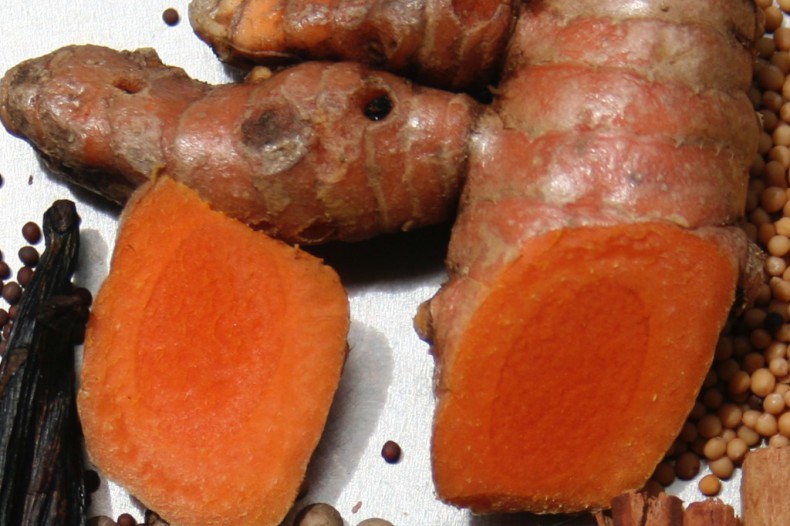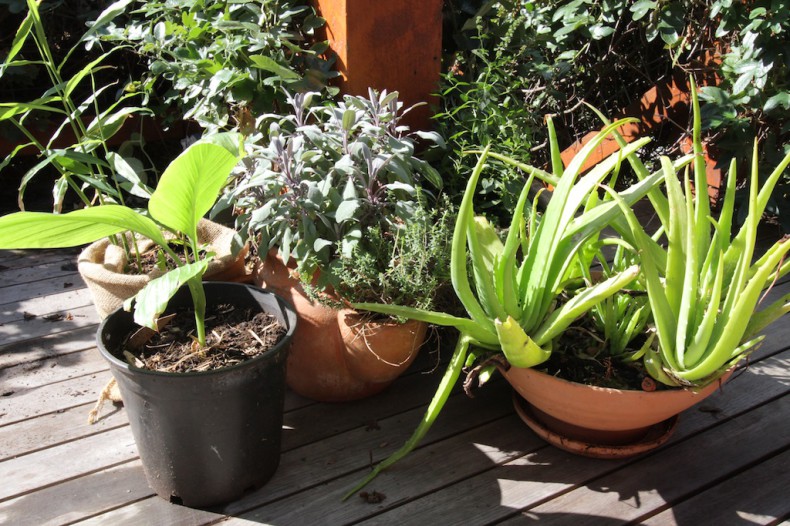Known in India as grandmother’s herb the root of this ‘cure all’ plant is antiseptic and astringent. Turmeric is a herbaceous perennial that grows from the characteristic orange yellow rhizome with broad oblong leaves. It thrives in tropical and sub-tropical regions planted into well-drained humus-rich soils in autumn. In cooler regions plant into large pots, full of composty soil and sit the pot in a sunny position where it will receive almost no water during late autumn, winter and early spring, but make sure it gets plenty of water once the weather warms up. Turmeric is a heavy feeder so top up with compost or manures or blood and bone every few weeks once it starts vigorously growing in spring. Daughter rhizomes can be harvested any time through the growing season and used fresh, or the whole plant is dug in autumn and those rhizomes not replanted, washed, boiled for about 4 hours and then removed and left to dry in a sunny position until hard and brittle. The root is then ground to a powder and stored in well-sealed dark glass jar. I use the fresh or powdered root to treat cuts, scrapes and bruises, or make an infusion by pouring boiling water over a teaspoon of chopped or powdered root for nausea, travel sickness and hangovers.
In India, turmeric is known as haldi and has been the classic grandmother’s remedy for a host of childhood ailments, but especially for grazes, cuts and bruises. It has been used in ceremonies in some countries to signify purity; for example in India, turmeric is still used to anoint a bride before marriage, and in Thailand a novice is still anointed with turmeric before his ordination as a monk.
Medicinal Uses
In her really interesting book Younger Skin in 28 Days, nutritionist Karen Fischer, describes the curcumin found in turmeric as having been ‘widely researched because it has an exciting spectrum of therapeutic activities including anti-inflammatory, anti-oxidant, anti-cancer, anti-bacterial, anti-fungal, anti-viral and blood thinning properties. In lab studies, curcumin improves collagen formation and accelerates wound healing; it inhibits advanced glycation end product formation and prevents collagen cross-linking and damage.’ Even if you think you don’t need the younger skin, it is worth reading for the nutritional information on a range of different vegetables, herbs and spices.
The following is an extract from my book Grow Your Own Herbal Remedies
Part used: fresh and dried roots
Circulatory system
Heart, High blood pressure, High cholesterol
Drink an infusion to reduce cholesterol in the blood stream and to thin blood. Drinking an infusion also reduces the risk of strokes and heart attacks.
Digestive system
Acidity and indigestion, Gastroenteritis, Nausea and vomiting
Drink an infusion to combat nausea, gastroenteritis and acidity. It also increases the production of mucus in the gut, so helping to protect it.
Fungal infections
Athlete’s foot
Use a poultice applied to the skin to treat athlete’s foot.
Hangover
Drink an infusion to ease the symptoms of a hangover.
Liver
Drink an infusion to improve the action of the liver. In both India and China it is used to treat jaundice.
Rheumatoid arthritis and osteoarthritis
Drink an infusion to reduce inflammation to help arthritis.
Skin
Eczema, Psoriasis
Use a poultice applied to the skin to treat psoriasis. Drink an infusion as an anti-inflammatory to help eczema.
Travel sickness
Drink an infusion to ease nausea generally and travel sickness in particular.
Wounds and sores
Use the moistened dry powder or the grated fresh roots as a poultice for cuts, wounds and grazes.
Warnings
Turmeric can sometimes cause skin rashes. If taken internally in medicinal doses, avoid over-exposure to the sun


